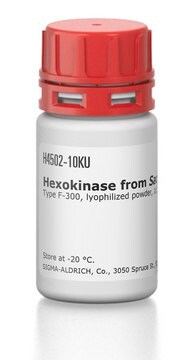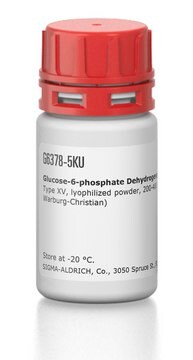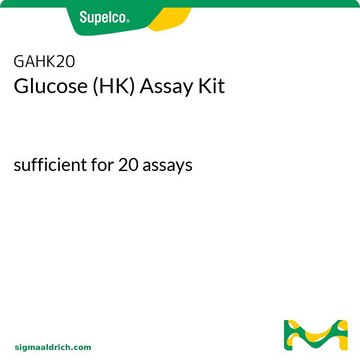Wichtige Dokumente
H5000
Hexokinase aus Saccharomyces cerevisiae
Type III, lyophilized powder, ≥25 units/mg protein (biuret)
Synonym(e):
ATP:D-Hexose-6-phosphotransferase, Hexokinase aus Hefe
About This Item
Empfohlene Produkte
Typ
Type III
Form
lyophilized powder
Spezifische Aktivität
≥25 units/mg protein (biuret)
Mol-Gew.
dimer 110 kDa
Fremdaktivität
glucose-6-phosphate dehydrogenase and phosphoglucose isomerase ≤10%
Lagertemp.
−20°C
Angaben zum Gen
bakers yeast ... HXK1(850614) , HXK2(852639)
Suchen Sie nach ähnlichen Produkten? Aufrufen Leitfaden zum Produktvergleich
Biochem./physiol. Wirkung
Die Phosphorylierungsrate unterscheidet sich je nach den Hexosen (pH 7,5, 30 °C).
D-Fructose KM: 0,33 mM
D-Glucose KM: 0,12 mM
D-Mannose KM: 0,05 mM
Hefe-Hexokinase existiert als zwei ähnliche Isoformen, PI und PII (A und B), mit einem isoelektrischen Punkt von 5,25 bzw. 4.
Molekülmasse: ~ 54 kDa (Monomer)
~ 110 kDa (Dimer)
Optimaler pH-Wert: 7,5 bis 9,0
Extinktionskoeffizient: E1 % = 8,85 (PI) und 9,47 (PII) bei 280 nm
Aktivatoren: Hexokinase erfordert Mg2+-Ionen (KM = 2,6 mM) für die Aktivität. Hexokinase wird von Katecholaminen und damit verbundenen Verbindungen aktiviert.
Inhibitoren: Sorbose-1-Phosphat, Polyphosphate, 6-Deoxy-6-fluorglucose, 2-C-Hydroxymethylglucose, Xylose, Lyxose und thiolreaktive Verbindungen (Hg2+ und 4-Chlormercuribenzoat)
Einheitendefinition
Physikalische Form
Lagerklassenschlüssel
11 - Combustible Solids
WGK
WGK 3
Flammpunkt (°F)
Not applicable
Flammpunkt (°C)
Not applicable
Persönliche Schutzausrüstung
Eyeshields, Gloves, type N95 (US)
Hier finden Sie alle aktuellen Versionen:
Besitzen Sie dieses Produkt bereits?
In der Dokumentenbibliothek finden Sie die Dokumentation zu den Produkten, die Sie kürzlich erworben haben.
Kunden haben sich ebenfalls angesehen
Unser Team von Wissenschaftlern verfügt über Erfahrung in allen Forschungsbereichen einschließlich Life Science, Materialwissenschaften, chemischer Synthese, Chromatographie, Analytik und vielen mehr..
Setzen Sie sich mit dem technischen Dienst in Verbindung.









